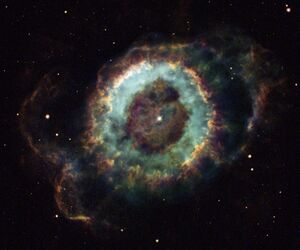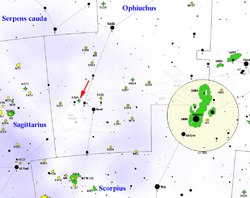Astronomy:Little Ghost Nebula
| Emission nebula | |
|---|---|
| Planetary nebula | |
 | |
| Observation data: J2000 epoch | |
| Right ascension | 17h 29m 20.457s[1] |
| Declination | −23° 45′ 34.77″[1] |
| Distance | 2,000 - 5,000 [2] ly |
| Apparent magnitude (V) | 12.00[1] |
| Apparent dimensions (V) | 28″[1] |
| Constellation | Ophiuchus[2] |
| Physical characteristics | |
| Radius | 0.136-0.34[citation needed] ly |
| Designations | NGC 6369, PK 002+05 1[1] |
Little Ghost Nebula, also known as NGC 6369, is a planetary nebula in the constellation Ophiuchus.[2] It was discovered by William Herschel.[3]
Round and planet-shaped, the nebula is also relatively faint. The high energy radiation from the central white dwarf causes the surrounding nebula to emit light.[4] The nebula's main ring structure is about a light-year across and the glow from ionized oxygen, hydrogen, and nitrogen atoms are colored blue, green, and red respectively.
The Little Ghost Nebula should not be confused with the Ghost Nebula (Sh2-136) or the Ghost Head Nebula (NGC 2080).
The central star of the planetary nebula has a spectral type of [WO3], indicating a spectrum similar to that of an oxygen-rich Wolf–Rayet star.[5] An analysis of Gaia data suggests that the it may be a binary system.[6] The central star was monitored by Kepler, but it was not found to be variable.[7]
References
- ↑ Jump up to: 1.0 1.1 1.2 1.3 1.4 "NGC 6369". SIMBAD. Centre de données astronomiques de Strasbourg. http://simbad.u-strasbg.fr/simbad/sim-basic?Ident=NGC+6369.
- ↑ Jump up to: 2.0 2.1 2.2 "Little Ghost Nebula (NGC 6369)". http://www.esa.int/Science_Exploration/Space_Science/Exploring_space/Little_Ghost_Nebula_NGC_6369.
- ↑ Nemiroff, R.; Bonnell, J., eds (8 November 2002). "NGC 6369: The Little Ghost Nebula". Astronomy Picture of the Day. NASA. https://apod.nasa.gov/apod/ap021108.html.
- ↑ "NGC 6369: Little Ghost Nebula". https://science.nasa.gov/ngc-6369-little-ghost-nebula.
- ↑ González-Santamaría, I.; Manteiga, M.; Manchado, A.; Ulla, A.; Dafonte, C.; López Varela, P. (2021). "Planetary nebulae in Gaia EDR3: Central star identification, properties, and binarity". Astronomy & Astrophysics 656: A51. doi:10.1051/0004-6361/202141916. Bibcode: 2021A&A...656A..51G.
- ↑ Chornay, N.; Walton, N. A.; Jones, D.; Boffin, H. M. J.; Rejkuba, M.; Wesson, R. (2021). "Towards a more complete sample of binary central stars of planetary nebulae with Gaia". Astronomy & Astrophysics 648: A95. doi:10.1051/0004-6361/202140288. Bibcode: 2021A&A...648A..95C.
- ↑ Jacoby, George H.; Hillwig, Todd C.; Jones, David; Martin, Kayla; De Marco, Orsola; Kronberger, Matthias; Hurowitz, Jonathan L.; Crocker, Alison F. et al. (2021). "Binary central stars of planetary nebulae identified with Kepler/K2". Monthly Notices of the Royal Astronomical Society 506 (4): 5223–5246. doi:10.1093/mnras/stab2045.
Coordinates: ![]() 17h 29m 20.44s, −23° 45′ 34.22″
17h 29m 20.44s, −23° 45′ 34.22″
External links
- Little Ghost Nebula data sheet, altitude charts, sky map and related objects - Deep Sky Objects Browser
- Little Ghost Nebula amateur astrophotography[yes|permanent dead link|dead link}}] - Deep Sky Objects Browser
 |


